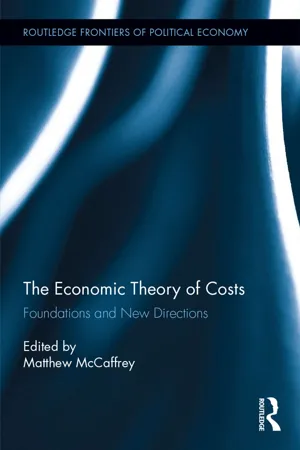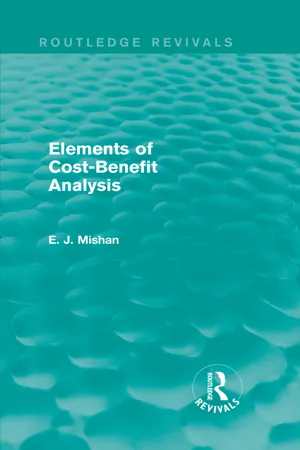Economic Cost
Economic cost refers to the total opportunity cost of resources used to produce a good or service. It includes both explicit costs, such as wages and rent, and implicit costs, such as the opportunity cost of using owner-supplied resources. Economic cost is a crucial concept in determining the profitability and efficiency of production in a market economy.
6 Key excerpts on "Economic Cost"
- eBook - ePub
- Andrew Barkley, Paul W. Barkley(Authors)
- 2020(Publication Date)
- Routledge(Publisher)
...Accounting costs are explicit costs, or payments that a business firm must actually make in order to obtain factors of production: USD 2000 for fertilizer, USD 25,000 for a new truck, USD 350 for seed, and the like. • Accounting Costs = explicit costs of production; costs for which payments are required. Bookkeepers and accountants consider only accounting costs. Economists include opportunity costs, which are the value of a resource in its next-best use. • Opportunity Costs = the value of a resource in its next-best use. What an individual or firm must give up in order to do something. Opportunity costs exist for every human activity. By studying economics, a student gives up the opportunity to study the “next-best alternative,” which might be studying biology, listening to music, partying, or seeing a movie. When individuals decide to become farm operators, they give up the opportunity to be a professor, or a mechanic, or whatever their next-best occupational choice might be. Suppose a college student cannot decide between studying to be a soil scientist or a veterinarian. The student cannot be both. If she becomes a soil scientist, her opportunity cost would be the income she gave up by not being a veterinarian. At another level, suppose that Jay Z, who likely makes a fortune with his personality as an entertainer, actually would prefer to be a social worker. The opportunity cost of his being a social worker is what he would have to give up from his entertainment career: surely millions of dollars. Apparently, he prefers the millions to what might be a more satisfying life as a social worker. This concept of opportunity cost is quite powerful, and is useful in explaining both economic and noneconomic behavior. All resources (and all occupational choices) have opportunity costs associated with them. The opportunity cost of planting one acre of land to cotton is the money lost by not planting the next-best alternative crop on that acre of land...
- eBook - ePub
Contemporary Economics
An Applications Approach
- Robert Carbaugh(Author)
- 2016(Publication Date)
- Routledge(Publisher)
...To calculate this cost, we simply identify all the resources used in production, determine their value, and then add things up. Explicit Costs and Implicit Costs Economists define the total cost of production as the sum of explicit costs and implicit costs. Explicit costs are payments made to others as a cost of running a business. For a local Pizza Hut franchise, explicit costs would include wages paid to labor, the cost of materials and electricity, telephone and advertising expenses, rental charges for the restaurant, health insurance for employees, and the like. Implicit costs are the costs that represent the value of resources used in production for which no monetary payment is made. For Pizza Hut, implicit costs might include the forgone salary of the restaurant owner who uses her time to run the business. It might also include forgone interest because the owner invests her funds in the firm rather than depositing them into her savings account. If the owner uses her building to house the restaurant, she also sacrifices rent that she could receive from other tenants. With implicit costs, no money changes hands. They represent the imputed value that the firm’s resources could command in their best alternative uses. Accounting Profit and Economic Profit Consider now what the term profit means. Most people think of profit as the difference between the amount of revenues a firm takes in (total revenue) and the amount it spends for wages, materials, electricity, and so on (total cost). If costs are greater than revenues, we call such “negative profits” losses. Although this description seems clear enough, accountants and economists have different views concerning the types of costs that should be included in total cost. As a result, they have different notions of profit. To an accountant, the following formula describes profit: Accounting profit = Total revenue − Explicit costs We know this definition of profit as accounting profit...
- eBook - ePub
Markets for Managers
A Managerial Economics Primer
- Anthony J. Evans(Author)
- 2014(Publication Date)
- Wiley(Publisher)
...George Shackle referred to costs as the ‘skein of imagined alternatives’ precisely because we never see costs. By definition costs relate to actions that we don't take, and we make a best attempt to place a monetary value on them. They're hard to measure, precisely because we never actually see them. So what is the ‘cost’ of choosing £20? The NBA is the £50 note and it is easy to estimate how much this is worth to us: £50. Sometimes we need to be explicit that we are talking about opportunity costs (also known as ‘hidden’ costs, or ‘implicit’ costs) rather than accounting costs, but a good economist will always define and use ‘cost’ as ‘the next best alternative’. And this isn't mere semantics; understanding the difference between economic and accounting costs can be a major source of competitive advantage. One way to implement opportunity cost reasoning within an organisation is the concept of ‘Economic Value Added’ (EVA), a registered trademark of Stern Stewart & Company. The role of an accountant is to value assets and protect bondholders from potential bankruptcy. But what about equity holders? Joel Stern developed EVA as a student at the University of Chicago, part of a tradition in corporate finance that aimed to measure the economic value of company's activities. 2 Put simply EVA is an attempt to make the hidden cost of capital more visible, allowing managers to monitor and reward genuine value creation. To an accountant ‘profit’ simply means that revenue exceeds costs. But to be economically profitable you need to go beyond ensuring that revenues exceed costs; you must deliver a profit that outperforms the next best alternative of the resources you utilise. The interest rate paid on government bonds is often used as a point of comparison, but most companies should be generating higher returns than this...
- eBook - ePub
The Economic Theory of Costs
Foundations and New Directions
- Matthew McCaffrey(Author)
- 2017(Publication Date)
- Routledge(Publisher)
...Consider, for example, Krugman and Wells (2009): “The concept of opportunity cost is crucial to understanding individual choice because, in the end, all costs are opportunity costs” (p. 7).4As Mises (1998) explains: “Acting man is eager to substitute a more satisfactory state of affairs for a less satisfactory” (p. 13). This insight is particularly useful in solving apparent conundrums in the logic of action. For example, McCaffrey (2015) uses it to address a separate criticism of causal-realist theory regarding love and gifts: “in theuniversal, praxeological sense, it is not material goods that are exchanged, but rather states of the world, as subjectively interpreted by the actor” (p. 213).5Rothbard’s (1956) “Toward a Reconstruction of Utility and Welfare Economics” is a seminal work in this literature.6See Boyes (2014) for an example of how opportunity costs may be applied in a critique of the Keynesian multiplier.7For other examples, see Acemoglu, Laibson, and List (2015, pp. 9, 12, 173), Chiang (2017, pp. 9, 36), Coppock and Mateer (2017, pp. 13, 35), Cowen and Tabarrok (2015, pp. 4, 17), Hubbard and O’Brien (2015, pp. 8, 39), Parkin (2015, pp. 9, 33), and Taylor (2007, pp. 5, 12).8Consider, for example, the two definitions offered in Chiang (2017): “Opportunity cost measures thevalueof the next best alternative use of your time and money, or what you give up when you make an economic decision” (p. 9, emphasis mine); and “Opportunity cost – The cost paid for one product in terms of theoutput(or consumption)of another productthat must be forgone” (p...
- eBook - ePub
- George Fink(Author)
- 2010(Publication Date)
- Academic Press(Publisher)
...X Economics and Costs of War Economic Costs and Consequences of War Carlos Seiglie Rutgers University, Newark, NJ, USA Microeconomic Analysis Macroeconomic Implications of War The Transfer Problem and War Toward Measuring the Cost of War Further Reading Glossary External Cost The cost borne by noncombatant nations in a war. Externality When the action of a nation (individual) affects the consumption or production opportunities available to another. Internal Cost The cost borne by combatant or participating nations in a war. Opportunity Cost The value of a resource in their next-best alternative use. Terms-of-Trade The price of commodities that are imported relative to the price of those that are exported by a country. Value of Life From an economic viewpoint it generally focuses on the amount an individual is willing to pay to avoid death with some probability. This is referred to as the value of a statistical life. From an insurance viewpoint, it is the amount required to make the victim ‘whole’. The losses generally consist of: (1) the loss of wages and employee benefits net of personal consumption and (2) the loss of household services. In analyzing the cost of war, it is convenient to classify or partition costs in two ways. First, a distinction should be made between whether the cost and consequences are internal or external, that is, whether they are borne directly by the participants or by the wider international community, respectively. This distinction is similar to the one made in economics between private and social costs. If the decisions to go to war are based on the calculus of whether the private benefits outweigh the private cost of going to war, then many wars could be prevented if the parties involved internalized the higher social cost imposed by their actions...
- E. Mishan(Author)
- 2015(Publication Date)
- Routledge(Publisher)
...Wherever such constraints affect the outcome of the evaluation, in particular where, in their absence, the investment decision would be otherwise, the economist has the duty of making the fact abundantly clear. Not even majority opinion is to be treated by him as the considered opinion of the nation, the voice of the people in council. Political decisions may be poor decisions for a large number of reasons too tedious to recount. Finally, the reader may be reminded that the economic criterion employed by the economist is one that is independent of voting procedures and, therefore, independent of the outcome of any particular political debate. In the last resort, the further information and analysis the economist can offer become a part of the contribution to a more informed debate which may occasionally reverse preceding political decisions. 1 In the case of capital, however, occupational preferences can be disregarded, leaving opportunity costs to be determined by earning differentials alone. If, in a short period, existing machines are specific to their existing function, their value elsewhere is nil and, therefore, their opportunity costs are nil. If, on the other hand, the machines have a range of uses (as, for instance, lathes) they can, at some cost of conversion, produce a value in other uses. In that case opportunity costs are positive. In any cost-benefit calculation, an existing machine has to be valued at this opportunity cost. Where such a machine has an existing number of alternative uses, it is clearly to be valued at the highest of the alternative opportunity costs. Earnings above this highest opportunity cost (sometimes known as its transfer price) are defined as quasi-rents, and accrue to the owners of the machine...





